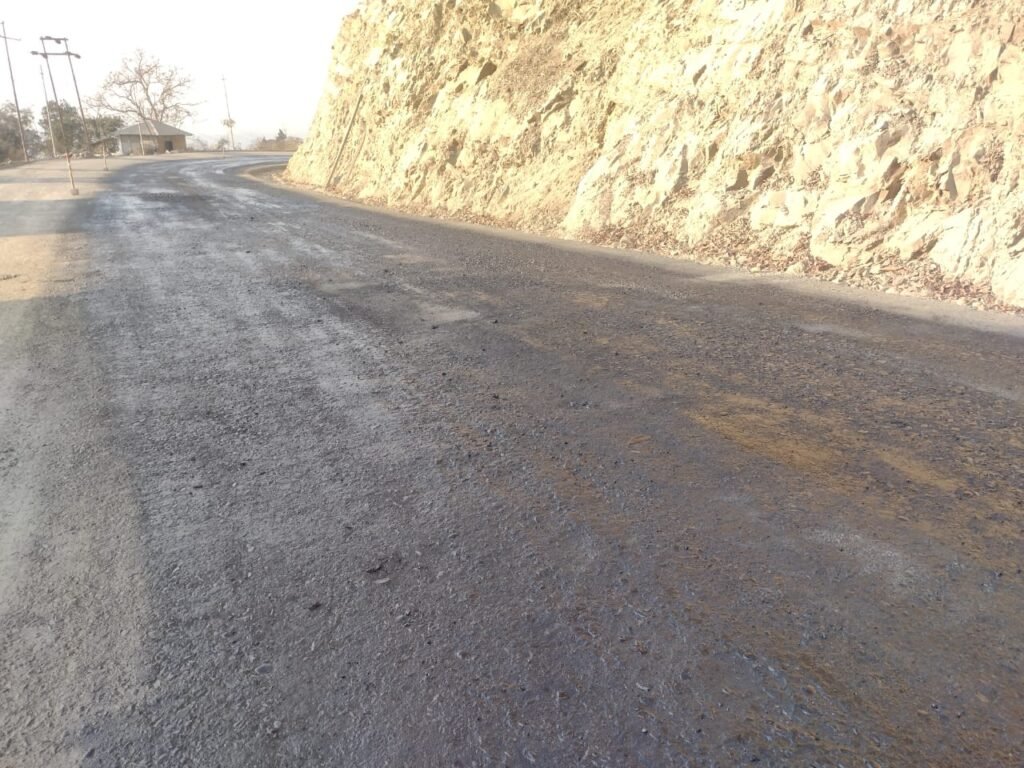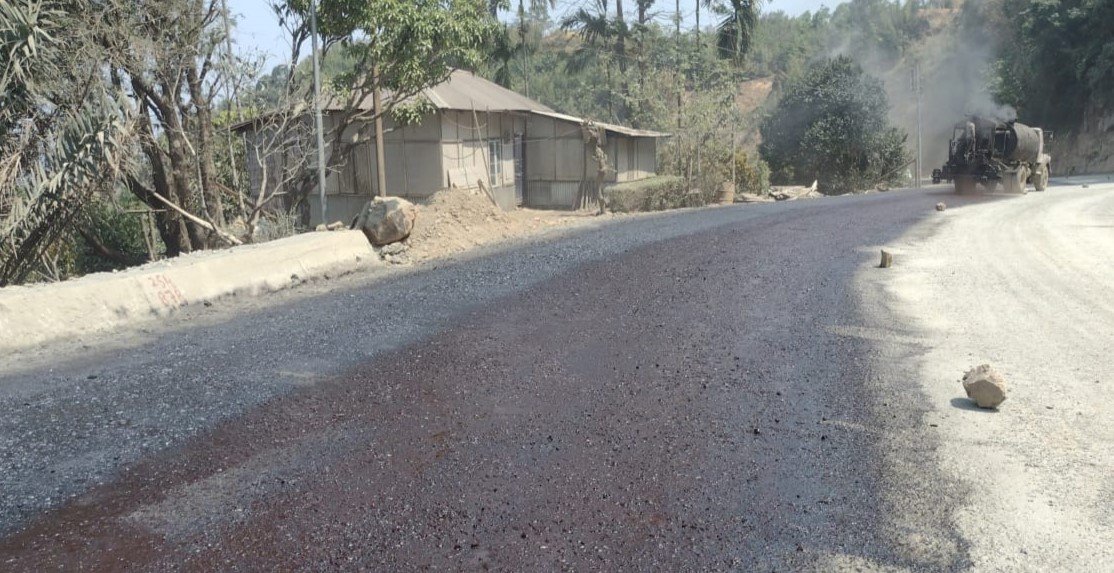The prime coat acts as a bonding agent between the base layer(WMM layer or WBM layer) and the subsequent asphalt layer (binder course or DBM layer) to increase the longevity of the road and later prepare the surface for the asphalt layer. Here, we learn the benefits of prime coats, application methods and the different types of materials used for prime coats in road construction.
Table of Contents
What is Prime Coat in Road Construction?
A prime coat is a low-viscosity bituminous material that is sprayed over a road base layer(WMM or WBM layer) that we commonly call granular or a stabilized sub-base afterward the bituminous surface (DBM or binder course) is installed in flexible pavement. It acts as a bonding agent between the base layer and the subsequent asphalt layer (binder course) which seals the surface and prevents water infiltration. Some common materials used for prime coating include cutback bitumen, emulsified bitumen and diluted bitumen.
Purpose of Prime Coat in Road Construction
The main roles of the prime coat in Road Construction include:
- Bonding: Prime Coat creates a significant bonding between the non-bituminous base and the bituminous top layer, making sure they stay together even with the pressure from traffic.
- Waterproofing: The prime coat seals the surface of the base layer, preventing water from seeping into base layer, which could weaken the structure and cause problems like potholes in road.
- Stabilization: The prime coat helps keep loose particles on the base layer in place, resulting in a more stable and even surface for laying down asphalt.

Types of Materials Used for Prime Coat in Road Construction
The selection of materials varies based on several factors, such as climate, type of base material, and budget. Commonly used materials include:
Cutback Bitumen
Cutback bitumen is a type of bitumen that’s mixed with solvents (often called cutters) to make it less thick and It is very easy to work with. Once applied, the solvent evaporates, leaving a sticky layer of bitumen that serves as a binder.
Types of Cutback Bitumen:
- Rapid-Curing (RC): This type of Cutback Bitumen has a lot of volatile solvents like gasoline, which means it dries up fast. It’s perfect for use in cold or damp weather. Typically contains 80-90% bitumen and 10-20% solvent.
- Medium-Curing (MC): This type has solvents that take a moderate amount of time to evaporate, like kerosene. It’s commonly used for prime and tack coats. Contains 70-80% bitumen and 20-30% solvent.
- Slow-Curing (SC): This version uses oils that take longer to evaporate, giving you more time to apply it. It’s great for projects that need deeper penetration into the base layer. Contains 60-75% bitumen and 25-40% solvent.
Advantages:
- Cutback Bitumen is super easy to apply, especially in cooler weather.
- Rapid-curing options speed up road construction.
- Cutback Bitumen is good at penetrating base layers effectively.
Disadvantages:
- The solvents can be harmful to the environment because of volatile organic compounds (VOCs).
- There’s a fire risk due to the flammable solvents involved.
Applications:
- Used for prime coating, tack coating and surface dressing in road construction.
- Helps with dust control on unpaved roads.
Bitumen Emulsion
Bitumen emulsion is a blend of bitumen, water, and an emulsifying agent. This agent keeps the bitumen droplets suspended in the water, allowing it to be applied at room temperature without needing to heat it up. After application, the water evaporates, leaving a layer of bitumen behind. Bitumen emulsions are a blend of 60-70% bitumen with 30-40% water and an emulsifying agent.
Types of Bitumen Emulsion:
- Rapid-Setting (RS): This type sets quickly when it comes into contact with aggregates, making it ideal for tack coats and surface treatments.
- Medium-Setting (MS): It has a moderate setting time, perfect for mixing with fine aggregates, like in cold mixes.
- Slow-Setting (SS): This one takes its time to set, giving you more leeway for mixing with base layers, making it great for prime coats.
Advantages:
- Bitumen Emulsion is eco-friendly since it doesn’t need heating and has no solvents.
- Safe to handle and store, with no fire hazards.
- Bitumen Emulsion is easy to apply in different weather conditions.
- Can be used on wet surfaces, which is a plus in humid areas.
Disadvantages:
- Needs proper storage to avoid separation of bitumen and water.
- Bitumen Emulsion has a shorter shelf life compared to other bitumen products.
- Not ideal for extremely cold weather where water might freeze.
Applications:
- Used for prime coats, tack coats, and surface treatments in road construction.
- Suitable for cold mix asphalt.
- Helps with dust suppression on roads and construction sites.
Diluted Asphalt
Diluted asphalt is a mix of asphalt cement with water or a thinner medium, making it less thick for easier application. While it’s not as commonly used as cutback bitumen or bitumen emulsions, it can be effective in specific situations. Diluted asphalt is often mixed with 50-70% asphalt cement and 30-50% water.
Different Types of Diluted Asphalt:
- Water-Cut Asphalt: This is typically used for making slurry seals or applying thin layers on roads.
- Additive-Enhanced Asphalt: Sometimes, additives are mixed in to improve certain features like stickiness or flexibility.
Advantages:
Prime Coat in Road Construction is budget-friendly and easy to mix. Works well on bumpy or uneven surfaces. Improves layer adhesion, especially on low-traffic roads.
Disadvantages:
Prime Coat in Road Construction is Mainly suited for specific uses, particularly slurry seals. Not as tough or long-lasting as other asphalt products. Application can be challenging if the temperature and humidity aren’t just right.
Applications:
Prime Coat in Road Construction is ideal for slurry seals and micro-surfacing to maintain surfaces. Good for lighter applications where a strong binder isn’t necessary. Commonly used for fixing and maintaining roads, pavements, and driveways.
Application Process of Prime Coat in Road Construction
- Surface Prep: Start by giving the base layer a good clean to get rid of any dust, dirt, or debris. This helps the prime coat stick well to the base.
- Choosing Prime Coat Material: Pick the right material based on the base type, climate, and environmental factors.
- Application: Use a distributor truck to spray the prime coat evenly over the base layer. Make sure to apply it at a steady rate to avoid puddles or runoff. For prime coats, the typical spray rate ranges between 0.6 to 1.2 liters per square meter (L/m²).
- Curing: Once applied, the prime coat needs some time to cure and soak into the base. The curing time varies depending on the material and weather, usually taking anywhere from a few hours to a full day.
Benefits of Using a Prime Coat in Road Construction
- Better Bonding: A Prime Coat in Road Construction creates a solid connection between the base layer and the asphalt, helping to prevent any slipping or separation.
- Moisture Protection: It acts as a waterproof barrier, shielding the base from water damage and boosting the road’s lifespan.
- Less Dust: The Prime Coat in Road Construction helps to hold down loose particles, which means less dust during construction.
- Longer Lifespan: With improved bonding and moisture resistance, the prime coat plays a key role in making roads last longer.
Challenges and Considerations of Prime Coat in Road Construction
Even though the prime coat has its perks, there are some challenges to keep in mind:
- Weather Impact: The weather can really affect how well the prime coat works. Rain or high humidity can mess with the curing process.
- Application Consistency: If the prime coat isn’t applied evenly, it can create weak spots that might lead to early road damage.
- Environmental Issues: Some materials, like cutback bitumen, use solvents that can harm the environment. Choosing eco-friendly options like bitumen emulsion can help address this concern.
Conclusion
The prime coat is essential in road construction for ensuring durability and longevity. By increasing the bond between the base and asphalt layers, it enhances the overall stability of the road. Choosing the right materials, applying them correctly and considering weather conditions can maximize the effectiveness of the prime coat, resulting in well and more durable roads.
Frequently Asked Questions
What is the temperature of prime coat Prime Coat in Road Construction in degrees celsius?
Prime Coat in Road Construction is usually applied at 20°C to 60°C. Heating may be needed if it’s cold.
What is the difference between primer coat and tack coat?
Prime coat is a low-viscosity bituminous layer that is applied to the base course (WMM) and sealed for asphalt layers (DBM). It penetrates and bonds the base (DBM) with the surface course (BC).
Tack coat is a thin layer of bituminous material applied between existing asphalt layers (DBM) to ensure proper bonding between them, providing adhesion for new layers (BC).

